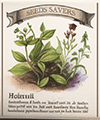
![]()
 Save Vegetable Seeds in Your Backyard
Save Vegetable Seeds in Your Backyard
This is an excellent article from The Mother Earth News by Richard P. King…Seed Savings Basics
BASICS | TECHNIQUES | STORAGE | LONGEVITY | GERMINATION | SEED CRAFT
Save vegetable seeds and you save money on gardening, become more food self-sufficient, create new, custom varieties of vegetables that grow best in your backyard, and have fun in the process!
One gardening encyclopedia tells its readers not to save seeds since they’re so plentiful and inexpensive it’s not worth the bother. Oh yeah? Take a careful look at this year’s colorful new seed catalogs, and then tell me seeds aren’t expensive. Until recently, my yearly order cost was between $20 and $25, and I suspect my case is not unusual.
It’s not necessary to spend $10 or $15 (or even $30) each year on seeds. I’ve found, by saving vegetable seeds from my own garden and then planting them the following year, I’ve cut my annual seed bill in half (despite the fact that the few seeds I do buy have risen sharply in price, and despite the fact that I like to experiment with exotic and generally expensive plant varieties). If you have a large garden — and if you can discipline yourself to resist those glowing seed catalog pictures and descriptions — you could easily save on your seed bill, too.
This year, plan to collect, store and use some of the seed your own garden gives you for free? It isn’t hard to do, and the rewards (if you ask me) more than justify the small amount of effort involved.
First, a Few Seed Saving Basics
![]() Before the actual “here’s how” of preserving seeds, I’d like to offer a few observations that could save you a good deal of frustration or disappointment.
Before the actual “here’s how” of preserving seeds, I’d like to offer a few observations that could save you a good deal of frustration or disappointment.
First of all, hybrid varieties (you’ll see the word “hybrid” in the seed catalog description or in the vegetable’s name) do not always breed true to type. The seed from last season’s mammoth tomatoes may only produce scraggly plants bearing tiny red buttons the following season. To avoid this problem, always start with standard (non-hybrid) vegetable varieties, or stick with hybrids that you know will breed true.
Second, if you plant two or more standard varieties of corn (squash, tomatoes, or any flowering vegetables) you’re likely to have cross-pollination by wind and/or insects. This results in an uncertainty of your seed quality (a rare result is a new hybrid of higher quality than the two varieties with which you started … but this is highly unlikely). You can minimize this cross-fertilization process by planting only one variety of corn (or squash, tomato, etc.) at a time and locating your plot as far as possible from your neighbor’s patch.
Third, keep in mind that many common vegetables (root crops, cabbages, parsley, and Brussels sprouts) are biennial. Biennial means the plants do not form seed pods until their second year. Here in Minnesota, such vegetables have to be mighty hardy to survive an entire winter in the ground (beets, for instance, are not that hardy and, as a result, I purchase new beet seeds each year). I always leave a few carrots in the garden over the winter months, however, since carrots are cold-resistant by nature. The following spring, they produce tops that grow up to two feet tall. Then they send out white flowers that resemble Queen Anne’s lace (the wild plant from which carrots were originally developed). Eventually, tiny seeds form that you can collect.
Seed Saving Techniques: When To Collect, How To Collect
![]() For fleshy vegetables such as tomatoes, squash, and melons, pick them when they are fully ripe. Scoop out their seeds and spread them to dry in a well-ventilated place. Beans and peas need to be left on the vine until the pods are dry and crackly. Corn should also be left to dry on the stalk until the kernels dent. Other types of seed may be gathered when the fruit or vegetables are fully formed, hard, and “meaty.” Remember to collect seeds only from the most vigorous plants in your garden, and not just from the first few ripe specimens you happen to encounter. By selecting seeds from just the healthiest plants, you will – over time – select for and create a special sub-variety of these crops that are specially adapted to your backyard’s climate and soil.
For fleshy vegetables such as tomatoes, squash, and melons, pick them when they are fully ripe. Scoop out their seeds and spread them to dry in a well-ventilated place. Beans and peas need to be left on the vine until the pods are dry and crackly. Corn should also be left to dry on the stalk until the kernels dent. Other types of seed may be gathered when the fruit or vegetables are fully formed, hard, and “meaty.” Remember to collect seeds only from the most vigorous plants in your garden, and not just from the first few ripe specimens you happen to encounter. By selecting seeds from just the healthiest plants, you will – over time – select for and create a special sub-variety of these crops that are specially adapted to your backyard’s climate and soil.
Seed Storage
![]() Also, remember to label and store your free bonanza as soon as possible after harvesting. You may think you’ll be able to recall the name of each kind of seed, but believe me — it’s easy to get confused. Some (broccoli, cabbage, and cauliflower seeds) resemble one another quite closely.
Also, remember to label and store your free bonanza as soon as possible after harvesting. You may think you’ll be able to recall the name of each kind of seed, but believe me — it’s easy to get confused. Some (broccoli, cabbage, and cauliflower seeds) resemble one another quite closely.
Envelopes make good containers for storing small quantities of most kinds of seeds since they can be sealed and labeled conveniently. For larger quantities, I use glass jars (they take up more space than envelopes and are breakable, but you can see inside them).
I label my seed containers with the following: Each kind of vegetable, variety of vegetables, where and when I originally bought the seed, and the month and year of the harvest.
Example: Bush snap beans — Blue-Lake Park (1970) — August 1976.
The Key To Successful Seed Storage
![]() The key to successful long-term seed storage is keeping your cache cool and dry. If you store your seeds where the air is moist, they may sprout and/or become mildewed (Tip: You may want to put a small amount of powdered milk into each storage container to act as a desiccant). Mold growth occurs at a faster rate in warm air than it does in cool air.
The key to successful long-term seed storage is keeping your cache cool and dry. If you store your seeds where the air is moist, they may sprout and/or become mildewed (Tip: You may want to put a small amount of powdered milk into each storage container to act as a desiccant). Mold growth occurs at a faster rate in warm air than it does in cool air.
Potato and onion sets may be stored in open boxes or hung in mesh bags in a place where the temperature is 35 to 40 degrees Fahrenheit, and the air is not overly dry. We store ours in a frost-free fruit cellar along with our canned goods and winter squash (my neighbor, on the other hand, has had good luck squirreling away his eatin’ spuds and seeds in a 4-foot-deep pit dug in a sandy, well-drained spot. When he unearths them in early May, the potatoes and seeds look just like they did the previous September, without a single sprout!).
Seed Longevity: How Long Will Your Seeds Keep?
![]() Some seeds keep much longer than others. The following chart will give you an idea as to the minimum length of time properly stored seeds will remain viable.
Some seeds keep much longer than others. The following chart will give you an idea as to the minimum length of time properly stored seeds will remain viable.
TYPE OF SEED USEFUL LIFE (YEARS)
| Asparagus | 4 |
| Beans, string | 2 |
| Broccoli | 3 |
| Cabbage | 3 |
| Carrots | 4 |
| Cucumber | 5 |
| Lettuce | 5 |
| Onion | 2 |
| Pea | 2 |
| Pumpkin | 6 |
| Radish | 3 |
| Spinach | 5 |
| Squash | 4 |
| Tomato | 3 |
| Turnip | 3 |
Seed Longevity does fluctuate. Some of the above seeds may — depending on the particular variety and the storage conditions — remain usable for up to 10 years.
Germination Testing: Are My Seeds Still Alive?
![]() Years ago, I helped carry out germination tests for a large store that bought seed in bulk and repacked it in small packets for resale. Since the manager carried his unsold stock over from year to year, it was important for us to know how many seeds in a particular batch would sprout when planted.
Years ago, I helped carry out germination tests for a large store that bought seed in bulk and repacked it in small packets for resale. Since the manager carried his unsold stock over from year to year, it was important for us to know how many seeds in a particular batch would sprout when planted.
To test how many would sprout, first, we placed moistened cotton in a petri dish. Then we did the following:
- place exactly 100 seeds on top of the damp cotton,
- cover the dish,
- leave the dish at room temperature for a week or a few days
- count the number of seeds that have begun to grow (if 90 out of 100 seeds have sprouted, the germination rate is 90 percent: This is considered a good rate).
I do essentially the same germination tests with my seeds now, except that I only use ten seeds per germination test, and I only test seeds that are more than a year old (if the seeds are less than two years old and look good, I assume that their germination rate will be high).
Any plastic or glass container that will hold a damp blotter, damp newspaper, or moistened cotton (along with the seeds) will work as well as a Petri plate. Just remember to label your containers with the date of the test and the variety of seeds being tested. Then – after a week or so – check on your sprouts. If eight out of 10 seeds in any given test sprout, you can assume the germination rate to be 80 percent (which is, of course, plenty good).
Seed Crafts, Seeds with High-Quality Protein
![]() Homegrown seeds have many uses, in addition to serving as the source of next year’s garden vegetables. Pumpkin and squash seeds, for instance, are extremely tasty and nutritious when roasted (my wife spent three years in Turkey and she tells me the people in that country eat squash seeds the way we gobble peanuts). Dried peas make good pigeon food if you’re into raising squabs (although it does take rather a lot of peas to do the job). In addition, many seeds have attractive shapes and colors that make them fun to use in craft projects. Last year, my future zucchini patch end up as a wall plaque!
Homegrown seeds have many uses, in addition to serving as the source of next year’s garden vegetables. Pumpkin and squash seeds, for instance, are extremely tasty and nutritious when roasted (my wife spent three years in Turkey and she tells me the people in that country eat squash seeds the way we gobble peanuts). Dried peas make good pigeon food if you’re into raising squabs (although it does take rather a lot of peas to do the job). In addition, many seeds have attractive shapes and colors that make them fun to use in craft projects. Last year, my future zucchini patch end up as a wall plaque!
Why not give seed saving a try? You will gain a new source of high-quality protein (and/or craft materials for seed crafts), and save money on your yearly gardening outlay of cash. Most importantly, you’ll have the satisfaction of knowing you are a little bit less dependent on someone else for the food on your table. Seed saving is one more step toward food self-sufficiency. All the more reason to save vegetable seeds!
![]()


